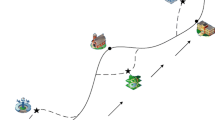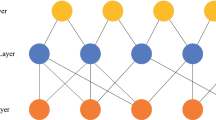Abstract
With the rapid development of location-based service technology, the leakage of trajectory privacy has become more and more serious. In order to solve the problems of insufficient privacy protection and low availability of published data in the existing trajectory privacy protection models, we propose a spatiotemporal generalized trajectory data publishing algorithm SGTP based on differential privacy. Firstly, a spatiotemporal generalization method of trajectories based on clustering is designed. The temporal location set is divided by a density peak trajectory clustering algorithm (DPTC), and the location is probabilistically generalized combined with an exponential mechanism to hide the real location information of users. Secondly, random noise is added to the generalized trajectory statistics by the Laplace mechanism, and the noise is post-processed by consistency constraints to improve the utility of the published data without affecting the privacy of the trajectories. Finally, we theoretically demonstrate that SGTP strictly satisfies differential privacy. Experimental results based on publicly available data show that SGTP can effectively protect user privacy and guarantee data utility and at the same time has a higher execution efficiency.











Similar content being viewed by others
References
Arif M, Chen J, Wang G et al (2021) Privacy preserving and data publication for vehicular trajectories with differential privacy. Measurement 173(108):675. https://doi.org/10.1016/j.measurement.2020.108675
Asuquo P, Cruickshank H, Morley J et al (2018) Security and privacy in location-based services for vehicular and mobile communications: An overview, challenges, and countermeasures. IEEE Intern Things J 5(6):4778–4802
Bordenabe NE, Chatzikokolakis K, Palamidessi C (2014) Optimal geo-indistinguishable mechanisms for location privacy. In: Proc. 2014 ACM SIGSAC conference on computer and communications security, pp 251–262
Deng X, Xin X, Gao T (2020) A location privacy protection scheme based on random encryption period for vsns. J Ambient Intell Humaniz Comput 11(3):1351–1359
Dong Y, Pi D (2018) Novel privacy-preserving algorithm based on frequent path for trajectory data publishing. Knowledge-Based Syst 148:55–65
Dwork C, McSherry F, Nissim K, et al (2006) Calibrating noise to sensitivity in private data analysis. In: Theory of cryptography conference, Springer, pp 265–284
Ghane S, Kulik L, Ramamohanarao K (2020) Tgm: A generative mechanism for publishing trajectories with differential privacy. IEEE Intern Things J 7(4):2611–2621
Gursoy ME, Liu L, Truex S, et al (2018) Utility-aware synthesis of differentially private and attack-resilient location traces. In: Proc. 2018 ACM SIGSAC Conference on Computer and Communications Security, pp 196–211
Hay M, Rastogi V, Miklau G et al (2010) Boosting the accuracy of differentially private histograms through consistency. Proc VLDB Endow 3(1–2):1021–1032. https://doi.org/10.14778/1920841.1920970
He X, Cormode G, Machanavajjhala A et al (2015) Dpt: differentially private trajectory synthesis using hierarchical reference systems. Proc VLDB Endow 8(11):1154–1165
Hua J, Gao Y, Zhong S (2015) Differentially private publication of general time-serial trajectory data. In: 2015 IEEE Conference on Computer Communications (INFOCOM), pp 549–557
Li M, Zhu L, Zhang Z et al (2017) Achieving differential privacy of trajectory data publishing in participatory sensing. Inform Sci 400:1–13
Li X, Zhang H, Ren Y et al (2020) Papu: Pseudonym swap with provable unlinkability based on differential privacy in vanets. IEEE Intern Things J 7(12):11,789-11,802
Liu Q, Yu J, Han J et al (2021) Differentially private and utility-aware publication of trajectory data. Expert Syst Appl 180(115):120
Ma Z, Zhang T, Liu X et al (2019) Real-time privacy-preserving data release over vehicle trajectory. IEEE Trans Veh Technol 68(8):8091–8102
Mahdavifar S, Deldar F, Mahdikhani H (2022) Personalized privacy-preserving publication of trajectory data by generalization and distortion of moving points. J Net Syst Manag 30(1):1–42
McSherry F, Talwar K (2007) Mechanism design via differential privacy. In: 48th Annual IEEE Symposium on Foundations of Computer Science (FOCS’07), pp 94–103
McSherry FD (2009) Privacy integrated queries: an extensible platform for privacy-preserving data analysis. In: Proc. 2009 ACM SIGMOD International Conference on Management of data, pp 19–30
Naini FM, Unnikrishnan J, Thiran P et al (2016) Where you are is who you are: User identification by matching statistics. IEEE Trans Inform Forensics Sec 11(2):358–372
Peng T, Liu Q, Meng D et al (2017) Collaborative trajectory privacy preserving scheme in location-based services. Inform Sci 387:165–179
Shaham S, Ding M, Liu B et al (2021) Privacy preserving location data publishing: a machine learning approach. IEEE Trans Knowl Data Eng 33(9):3270–3283. https://doi.org/10.1109/TKDE.2020.2964658
Wang H, Li Y, Gao C et al (2021) Anonymization and de-anonymization of mobility trajectories: Dissecting the gaps between theory and practice. IEEE Tran Mob Compt 20(3):796–815. https://doi.org/10.1109/TMC.2019.2952774
Yang W, Sun YE, Huang H et al (2021) Persistent transportation traffic volume estimation with differential privacy. J Am Intell Humaniz Compt 12(1):213–231
Yuan S, Pi D, Zhao X et al (2021) Differential privacy trajectory data protection scheme based on r-tree. Expert Syst Appl 182(115):215
Zeng X, Chen X, Peng X, et al (2022) Differentially private publication for related poi discovery. Journal of Ambient Intelligence and Humanized Computing pp 1–15
Zhang G, Zhang A, Zhao P (2020) Locmia: Membership inference attacks against aggregated location data. IEEE Intern Things J 7(12):11,778-11,788
Zhang J, Yang Q, Shen Y et al (2021) A differential privacy based probabilistic mechanism for mobility datasets releasing. J Am Intell Humaniz Compt 12(1):201–212
Zhang Z, Qin Z, Zhu L et al (2017) Cost-friendly differential privacy for smart meters: Exploiting the dual roles of the noise. IEEE Trans Smart Grid 8(2):619–626. https://doi.org/10.1109/TSG.2016.2585963
Zhao P, Zhang G, Wan S et al (2020) A survey of local differential privacy for securing internet of vehicles. J Supercompt 76(11):8391–8412
Zhao X, Pi D, Chen J (2020) Novel trajectory privacy-preserving method based on prefix tree using differential privacy. Knowledge-Based Syst 198(105):940
Zheng Y (2015) Trajectory data mining: an overview. ACM Trans Intell Syst Technol (TIST) 6(3):1–41
Acknowledgements
This work was supported by National Science and Technology Innovation 2030-Key Project of ”New Generation Artificial Intelligence” under Grant 2021ZD0113103.
Author information
Authors and Affiliations
Corresponding author
Ethics declarations
Conflict of interests
The authors declare that they have no known competing financial interests or personal relationships that could have appeared to influence the work reported in this paper.
Additional information
Publisher's Note
Springer Nature remains neutral with regard to jurisdictional claims in published maps and institutional affiliations.
Rights and permissions
Springer Nature or its licensor (e.g. a society or other partner) holds exclusive rights to this article under a publishing agreement with the author(s) or other rightsholder(s); author self-archiving of the accepted manuscript version of this article is solely governed by the terms of such publishing agreement and applicable law.
About this article
Cite this article
Qiu, S., Pi, D., Wang, Y. et al. SGTP: A Spatiotemporal Generalized Trajectory Publishing Method With Differential Privacy. J Ambient Intell Human Comput 14, 2233–2247 (2023). https://doi.org/10.1007/s12652-022-04481-w
Received:
Accepted:
Published:
Issue Date:
DOI: https://doi.org/10.1007/s12652-022-04481-w




